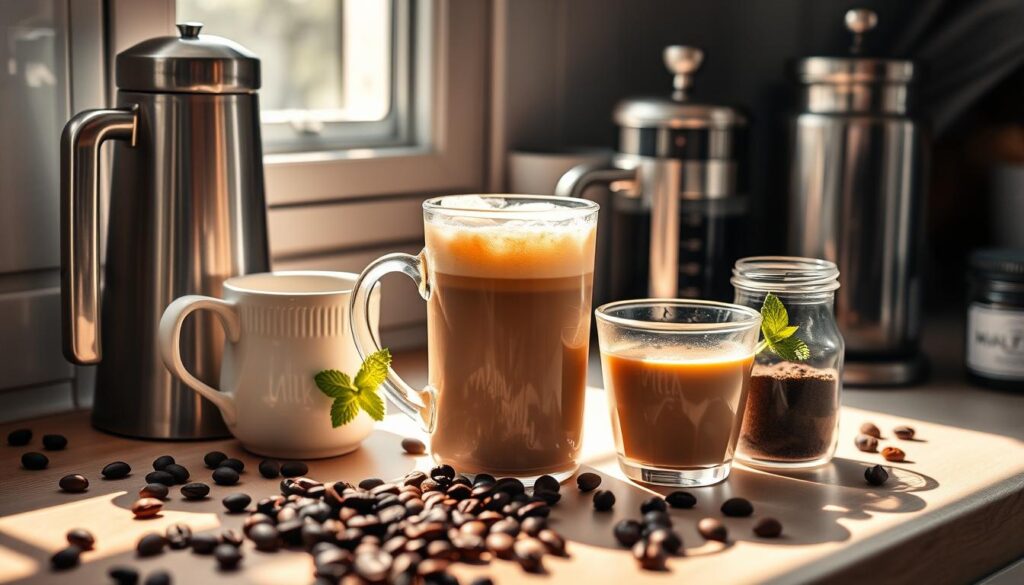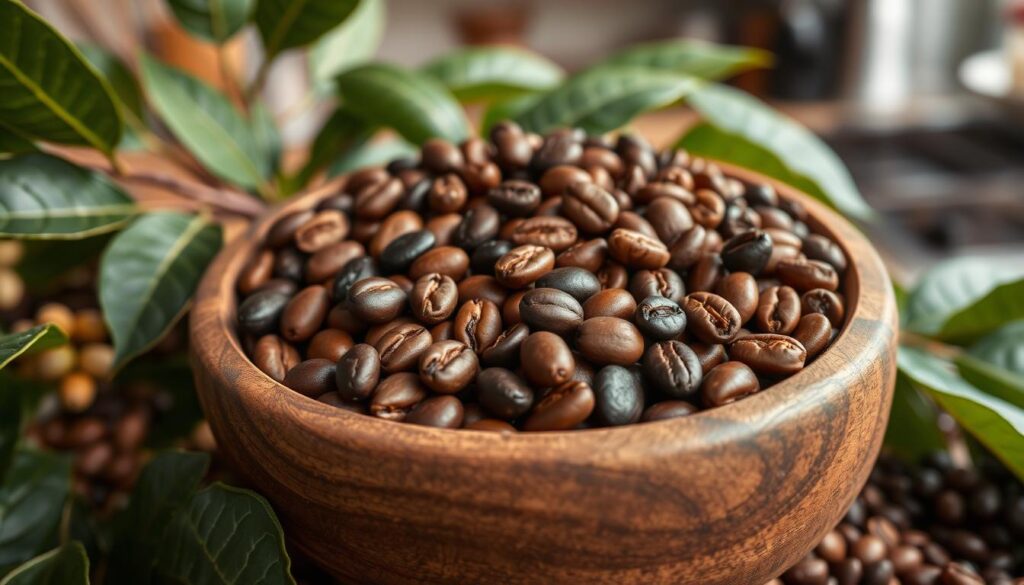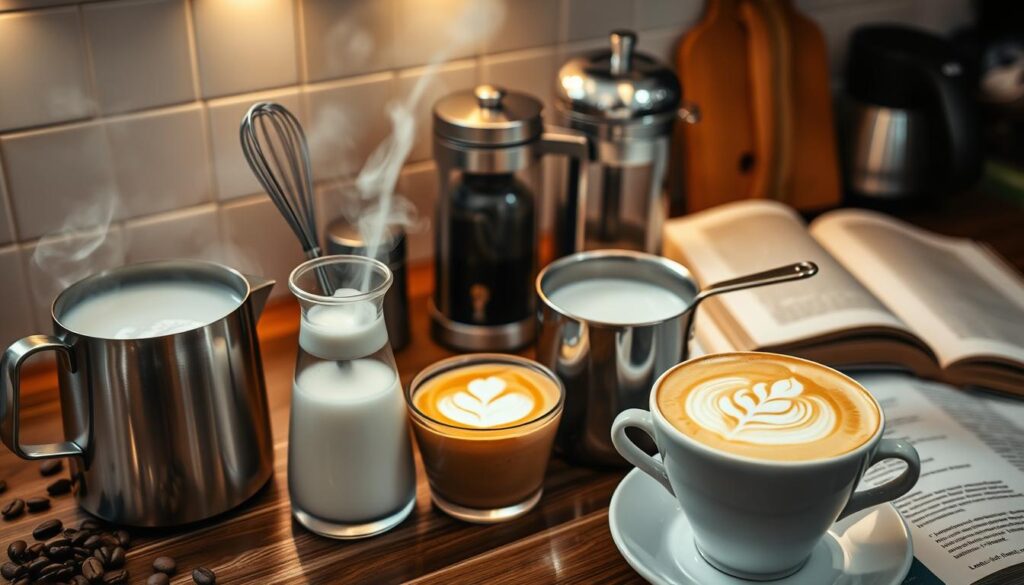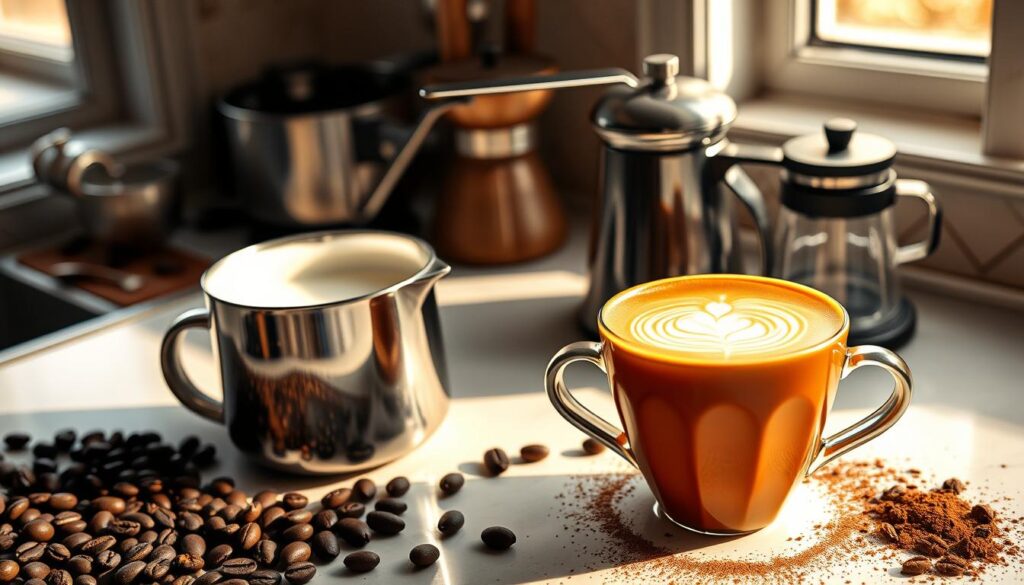Do you love the taste of a café latte but don’t have an espresso machine? You’re not alone. With a few simple steps, anyone can make amazing lattes at home.
Homemade lattes are more than just saving money. They’re about learning to make cafe-quality coffee right in your kitchen. This guide will show you how to make the perfect latte with tools and ingredients you already have.
You’ll learn how to pick the best coffee beans and how to froth milk like a pro. These skills will turn your morning coffee into a special treat.
Key Takeaways
- Create delicious lattes without specialized equipment
- Learn professional milk frothing techniques
- Understand coffee brewing fundamentals
- Save money by making café-style drinks at home
- Develop impressive barista skills
Understanding the Basic Components of a Perfect Latte
Making a great latte is more than just mixing coffee and milk. It’s an art that needs precision and knowledge of key elements. These elements turn a simple drink into a top-notch café experience.
The Ideal Coffee-to-Milk Ratio
The ratio of coffee to milk is key for a balanced latte. Baristas usually stick to a certain ratio:
- 1/3 espresso
- 2/3 steamed milk
- A thin layer of milk foam on top
“The perfect latte is about harmony between coffee and milk” – Specialty Coffee Association
Temperature Requirements for Professional Results
The temperature of a latte affects its taste and feel. The best temperatures are:
| Component | Ideal Temperature |
|---|---|
| Espresso | 190-196°F |
| Milk | 140-160°F |
Quality of Ingredients Matter
The quality of coffee is crucial for a great latte. Choose freshly roasted, high-quality beans and use filtered water. Fresh ingredients make your homemade latte truly special.
Essential Tools and Equipment for Home Latte Making
Making café-quality lattes at home is easy and affordable. You don’t need expensive gear. With the right tools, anyone can make tasty drinks like those from fancy coffee shops.

Here are the must-have tools to turn your kitchen into a coffee paradise:
- French press for brewing strong coffee base
- Milk frother for creating perfect foam
- Reliable coffee grinder
- Thermometer for precise milk temperature
- Large mug or latte glass
The milk frother is key for a creamy latte. You can find many affordable options:
- Manual handheld milk frothers
- Electric battery-powered frothers
- French press frothing technique
- Whisk method
“Great coffee is 90% preparation and 10% execution” – Professional Barista Wisdom
Quality home coffee tools don’t have to be pricey. Many affordable options can help you make amazing lattes at home.
| Tool | Cost Range | Effectiveness |
|---|---|---|
| French Press | $15-$40 | High |
| Handheld Milk Frother | $10-$25 | Medium |
| Electric Frother | $30-$80 | Very High |
The secret to great lattes at home is knowing how to use your tools well. Keep practicing, and you’ll get it right!
Choosing the Right Coffee Beans for Your Homemade Latte
Making the perfect latte begins with picking the right coffee beans. The beans you choose can turn a simple drink into a special coffee experience. Knowing about coffee beans can make your home brewing better and impress coffee lovers.

Best Roast Profiles for Lattes
Choosing the right roast is key for a tasty latte. Medium to dark roast beans are best for milk-based drinks. They offer a strong flavor that stands up to the milk’s creaminess.
- Medium roast: Balanced flavor with mild acidity
- Dark roast: Bold, intense coffee taste
- Espresso roast: Specially designed for milk-based beverages
Storage Tips for Maximum Freshness
Keeping your coffee fresh is important. It helps keep the beans’ flavor and aroma at their best. You should protect your coffee from air, moisture, heat, and light.
| Storage Method | Recommended Duration | Best Practices |
|---|---|---|
| Airtight Container | 2-4 weeks | Store in cool, dark place |
| Vacuum Sealed | 3-6 months | Keep away from direct sunlight |
Pre-grinding vs. Fresh Grinding
There’s a big debate about pre-grinding versus fresh grinding. Fresh grinding right before brewing is best for flavor and aroma. Whole beans keep their oils and complexity longer than pre-ground coffee.
“The moment you grind coffee beans, they begin to lose their flavor. Always grind just before brewing for the most vibrant taste.” – Coffee Roasting Expert
By focusing on the right coffee bean selection, roast profiles, storage, and grinding, you’ll make cafe-quality lattes at home.
How to Make Café-Style Lattes at Home Without an Espresso Machine
Making a tasty homemade latte is easy and doesn’t need fancy gear. You can make a top-notch drink at home with simple methods. The trick is to make a strong coffee and froth milk well.

- Strong Brewing Options:
- French Press method
- Moka pot brewing
- AeroPress technique
- Milk Frothing Strategies:
- Whisk technique
- Jar shaking method
- Manual frother
For the best coffee, pick a dark or medium-dark roast. Baristas say to use methods that get lots of flavor without bitterness.
| Brewing Method | Coffee Strength | Recommended Roast |
|---|---|---|
| French Press | Strong | Dark Roast |
| Moka Pot | Very Strong | Espresso Roast |
| AeroPress | Medium-Strong | Medium-Dark Roast |
“The secret to a great homemade latte is balancing coffee strength with milk texture.” – Coffee Enthusiast Magazine
Frothing milk takes time and practice. Begin with cold milk and whisk or shake it in a circle. This makes the foam smooth and creamy. The best temperature is between 140-160°F for the best taste and feel.
Pro tip: Let your coffee cool a bit before adding milk. This stops it from burning and keeps the flavor rich in your homemade latte.
Mastering the Art of Milk Frothing Without Professional Tools
Creating café-quality lattes at home is easy and doesn’t need expensive tools. You can make luxurious foam at home with simple techniques. Making DIY milk foam is surprisingly easy!

Baristas have secrets, but you can get similar results at home with kitchen tools. You can make creamy latte foam without spending a lot on fancy machines.
French Press Frothing Method
The French press is a surprising tool for frothing milk. Just follow these steps:
- Warm milk to about 140-160°F
- Pour milk into a clean French press
- Pump the plunger hard for 30-45 seconds
- Stop when the milk is foamy enough
Hand Frother Techniques
Handheld frothers are another great way to froth milk. They make rich, velvety foam quickly.
| Frother Type | Foam Quality | Ease of Use |
|---|---|---|
| Battery-Operated | Excellent | Very Easy |
| Manual Whisk | Good | Moderate |
Mason Jar Hack for Perfect Foam
The mason jar method is perfect for those on a budget. Just do this:
- Fill the jar halfway with warm milk
- Close the lid tightly
- Shake hard for 30-60 seconds
- Remove the lid and microwave for 30 seconds
“Great coffee is an art, and great foam is its canvas.” – Coffee Enthusiast
Pro tip: Always use fresh, cold milk for the best frothing results. Whole milk makes the most stable and creamy foam.
Alternative Brewing Methods for Strong Coffee Base
Making a tasty latte at home doesn’t need an expensive espresso machine. You can use several strong coffee brewing methods to make a rich coffee base for lattes.
Baristas and coffee lovers use three main brewing methods for a strong coffee base:
- Moka Pot: A classic Italian stovetop brewer that creates a robust, espresso-like coffee
- AeroPress: A versatile and quick brewing device producing smooth, strong coffee
- Pour-over coffee: A precision method for extracting maximum flavor and strength
The Moka pot is a traditional brewing tool for strong coffee. It uses steam pressure to make a concentrated coffee with bold flavors. It’s simple to use and makes a coffee drink similar to espresso.
“The secret to a great latte is not the machine, but the brewing technique.” – Coffee Artisan
AeroPress is another great choice for a strong coffee base. This small device uses manual pressure to brew coffee fast. It makes smooth and powerful coffee, loved by many for its quality and ease of use.
Pour-over coffee is a hands-on way to brew strong coffee. By controlling water temperature and pour rate, you can get nuanced flavors. This method makes a concentrated coffee perfect for lattes.
| Brewing Method | Strength Level | Brewing Time |
|---|---|---|
| Moka Pot | High | 5-10 minutes |
| AeroPress | Medium-High | 1-3 minutes |
| Pour-over | Medium | 3-4 minutes |
Each brewing method has its own benefits for a strong coffee base. Try different methods to find your favorite way to make lattes.
Creating Beautiful Latte Art at Home
Turning your homemade latte into a work of art is exciting. It mixes creativity with precision. Latte art makes a simple coffee drink into a feast for the eyes and taste.
To learn latte art, you need practice and to know how to pour milk. Baristas spend years honing their skills. But, you can learn basic designs quickly with the right steps.
Basic Pattern Techniques
Begin by learning a few basic patterns:
- Heart Design: The simplest and most classic latte art pattern
- Rosetta (Fern) Pattern: A slightly more advanced leaf-like design
- Tulip Shape: Creates elegant, stacked heart-like formations
Common Mistakes to Avoid
To succeed in latte art, avoid these mistakes:
- Incorrect milk temperature (should be 140-160°F)
- Poor milk texture and foam consistency
- Rushing the pouring technique
| Technique | Difficulty Level | Practice Time |
|---|---|---|
| Heart Design | Beginner | 1-2 weeks |
| Rosetta Pattern | Intermediate | 4-6 weeks |
| Tulip Shape | Advanced | 8-12 weeks |
Improving at latte art takes time. Watch tutorials, practice often, and don’t give up. Soon, you’ll make beautiful designs like the pros.
“Latte art is 50% skill, 50% passion, and 100% enjoyment” – Barista Wisdom
Remember, milk pouring techniques are key to great latte designs. Start simple, stay consistent, and enjoy the journey of making your coffee art.
Flavor Variations and Seasonal Latte Recipes
Take your coffee game to the next level with seasonal drinks. These special lattes turn simple coffee into a flavorful journey. With just a few ingredients, you can make lattes that taste like they came from a fancy cafe.
Homemade coffee syrups are key to making unique lattes. Try these tasty mixes:
- Vanilla Lavender Latte: Mix vanilla and dried lavender for a fancy taste
- Pumpkin Spice Latte: Blend cinnamon, nutmeg, and pumpkin for a fall favorite
- Caramel Maple Latte: Combine caramel and maple syrup for sweet indulgence
Making latte syrups at home is easy. Just mix sugar, water, and your favorite flavor. The fun part is trying new mixes to find your favorite.
“Great coffee is an art, and every home barista can become a master with creativity and practice.”
Seasonal drinks keep your coffee exciting. In summer, try citrus syrups. Winter is for spices like ginger and cardamom. Always use fresh, quality ingredients for the best taste.
- Summer: Lavender, Lemon, Honey
- Autumn: Pumpkin, Cinnamon, Maple
- Winter: Peppermint, Gingerbread, Chai
- Spring: Rose, Elderflower, Vanilla
Don’t be afraid to try new things and find your favorite seasonal coffee!
Troubleshooting Common Home Latte Problems
Making the perfect latte at home can be tough. Coffee troubleshooting is key for those who want to improve their skills. Even coffee experts face issues that can mess up their lattes.
Fixing Bitter Coffee Issues
Bitter coffee can spoil a great latte. Several things can cause this bad taste:
- Over-extraction during brewing
- Using stale or low-quality coffee beans
- Brewing at incorrect water temperature
To fix bitter coffee, try these tips:
- Use freshly roasted beans
- Grind coffee just before brewing
- Control water temperature between 195-205°F
- Reduce brewing time to prevent over-extraction
Achieving the Right Foam Consistency
Latte foam problems can affect your drink’s texture and look. Inconsistent milk foam often comes from wrong techniques or tools.
“The secret to perfect latte foam is patience and proper technique” – Professional Barista
Here are some tips for smooth, velvety foam:
- Use cold, fresh milk
- Choose whole milk for best results
- Angle your frothing tool correctly
- Practice consistent movement
With practice and these tips, you can make café-quality lattes at home.
Conclusion
Making the perfect café-style latte at home is a fun journey. You now know how to turn your kitchen into a coffee paradise. This guide has given you the tools to make lattes that compare to your favorite coffee shop.
The barista techniques you’ve learned are more than just recipes. They’re about the art of coffee making. From picking the best coffee beans to frothing milk, each step makes your coffee better. Keep practicing, and your skills will get better with each latte.
Be creative and passionate with every cup. Use a French press, hand frother, or try new brewing methods. Your skills will grow as you experiment. Trust your taste and enjoy the process of becoming a home barista.
Your coffee adventure is just starting. Keep learning, exploring, and enjoying every moment of making café-quality lattes at home.
FAQ
Can I make a latte without an espresso machine?
Yes, you can make lattes at home without an espresso machine. Use methods like French press, Moka pot, or AeroPress for strong coffee. Then, froth milk with tools like a hand frother or mason jar.
What type of coffee beans work best for lattes?
Medium to dark roast coffee beans are best for lattes. They have a rich flavor that pairs well with milk. Arabica beans are smooth and less bitter, making them great for lattes.
How do I froth milk without a professional frother?
Frothing milk at home is easy. Use a French press, mason jar, or hand-held frother. Each method can make creamy milk foam for your latte.
What’s the ideal coffee-to-milk ratio for a latte?
A latte should have a 1:3 coffee to milk ratio. This means one part espresso to three parts steamed milk, with a layer of foam on top.
How can I add flavor to my homemade latte?
Add flavor with syrups like vanilla or caramel. You can also use spices like cinnamon or cocoa powder. These add delicious complexity to your latte.
Why is my homemade latte tasting bitter?
Bitterness comes from over-extracted coffee, old beans, or high brewing temperatures. Use fresh beans, grind just before brewing, and avoid boiling to prevent bitterness.
Can I make latte art at home?
Yes, making latte art at home is possible. Start with simple designs like hearts or leaves. Pour milk slowly and steadily to create designs.
How important is coffee bean storage?
Storing coffee beans properly is key to freshness. Keep them in an opaque, air-tight container away from light, heat, and moisture. Grind beans just before brewing for the best flavor.
What alternative brewing methods can I use for my latte?
Use Moka pot, AeroPress, pour-over, or strong French press coffee as alternatives. These methods can make a concentrated coffee base for lattes.
Do I need special equipment to make a great latte at home?
No, you don’t need special equipment. Basic tools like a French press, hand frother, or whisk can make excellent lattes. It’s all about creativity and technique.
Share this post: on Twitter on Facebook

